Want to know how to pick an experienced lifter out of a sea of newbies? Take a look at their squat. Do they move any weight? Are they doing full squats? Do they squat at all? All three questions can usually be answered with a single glance.
But notice what question I didn't ask: Are they holding a barbell across their traps?
Make no mistake: The classic barbell squat is one of the cornerstones of countless great lifting programs. Done correctly, it will add size. It trains everything from your quads, glutes, and hamstrings to your intestinal fortitude. However, it's by no means the only squat variation, and it's not the only one that deserves consideration in your program.
Open your mind and get to know the all-stars of squatting, along with my favorite cues for each version of this essential movement.
Reigning Champ Back Squat
Advantages: Posterior chain power, hypertrophy
This is what you think of when you hear the word "squat." In my opinion, the back squat is the king of the strength-training world, and we're all just lucky to bask in its glory. Not only is it the most commonly utilized form of squatting—except for the half-squat, maybe—the full barbell back squat is one of the most effective exercises in the history of civilization for strengthening the lower body.
While it trains the entire lower body musculature, the back squat places greater emphasis on the muscles of the posterior chain, such as the glutes, hamstrings and spinal erectors, than other squat variations. It's also an unparalleled lower-body mass-builder, so if size is what you're after, you need to give it a serious look.
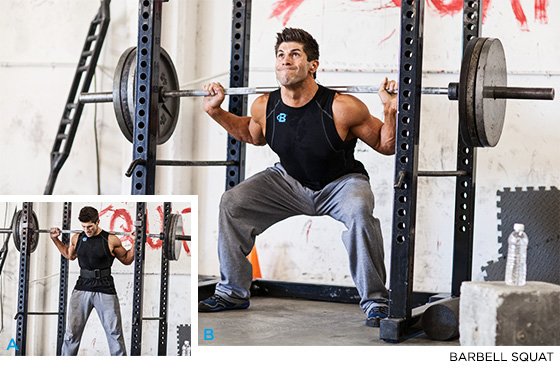
Cues: Grab the barbell with a grip slightly wider than shoulder width, step under the bar, and place it across your upper back just below the top of your trapezius. Be sure to keep your shoulder blades pulled tightly together and maintain a tight upper back throughout the lift.
After stepping out of the rack, initiate the movement by pushing your hips behind you. Keep your chest up and maintain an arched back while lowering yourself until the crease of your hip is lower than the top of your knee. Allow me to repeat that: lower than the top of your knee. Strongly reverse the movement until back to the starting position. That's one rep.
Challenger 1. Front Squat
Advantages: Balanced leg strength, core and upper back strength, harder to cheat
The front squat is quickly gaining popularity among a wide variety of athletes, partially because of its prominence in CrossFit protocols. It's also a crucial component of Olympic lifts. Whatever the reason you do it, it's an outstanding movement, not least of all because it's harder to do really badly than a back squat.
By locating the barbell across your shoulders in front of the body, the front squat puts much more emphasis on the quadriceps and upper back than the traditional back squat, but still trains the glutes and hamstrings well.
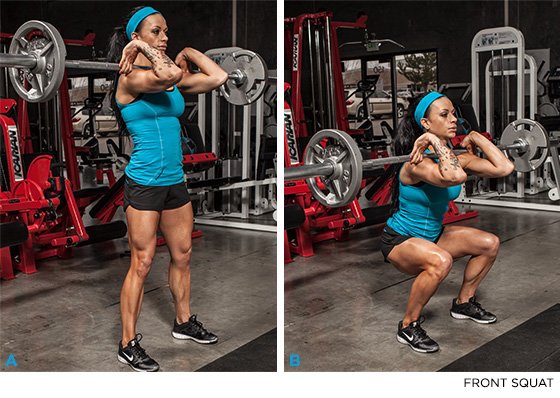
Cues: I prefer a clean grip for the front squat. To perform it this way, grab a barbell with a grip slightly wider than shoulder-width. Swing your elbows under the bar until they are pointing forward and the barbell rests across your shoulders in front of you.
Keep your elbows pointed forward throughout the movement. Squat while keeping your weight on your heels. Keep your chest and elbows up.
Challenger 2. Overhead Squat
Advantages: Balance, muscular control, increased mobility
Like front squats, overhead squats have their roots in Olympic weightlifting. The overhead squat strengthens the midpoint of the barbell snatch and is essential to mastering that particular lift. For non-competitive weightlifters, it can be an effective way to train the lower body while developing balance and mobility.
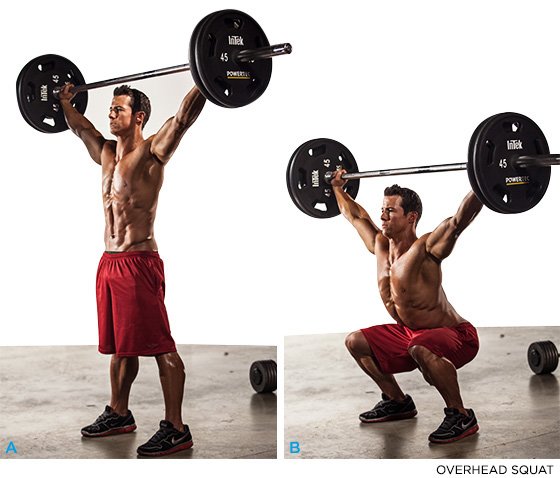
Cues: Snatch or press the barbell overhead and, while keeping it over your center of gravity, perform a squat. Overhead squats demand a certain degree of shoulder mobility to be executed correctly, but taking wide grip on the barbell makes this much easier.
You may find it difficult to use a heavy enough weight on the overhead squat to truly challenge your legs, but that's not the point here. The hip mobility demands it places on you carry over to all other squatting variations.
Challenger 3. Zercher Squats
Advantages: Torso and core strength, less spinal compression, carryover to deadlift
A fairly uncommon exercise in most gyms, the Zercher squat is one of the best movements out there for developing a strong upper back and torso. Despite being a squat, however, most lifters find that it has a strong carryover to the deadlift and embrace it for that reason.
Even so, it is a valuable addition to your program on its own merits. Be careful of loading this movement too heavily too quickly, though. You're holding the bar in your elbows, after all.
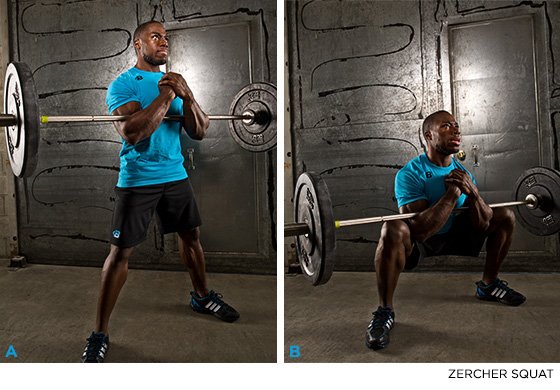
Cues: Real masochists, er, minimalists, start off by deadlifting a barbell off the floor, setting it on their thighs, hooking their elbows under the bar, and pressing it up. For the rest of us, place the barbell in the rack just lower than your sternum.
With your elbows bent at your side, place the barbell in the crook of your bent elbows. Squat until your elbows go between your knees or the bar touches your thighs. That's one advantage of the Zercher: It tells you when you reach depth.
Challenger 4. Anderson Squat
Advantages: Better control at depth, harder to cheat
This is another fairly uncommon squat variation, but if you try it for a while, you might find it has a great effect on the quality of your other squats when you switch back. Named after the legendary Olympic weightlifter and strongman Paul Anderson, the Anderson squat begins at the bottom of the squat. By doing this, you eliminate momentum and the "bounce," or stretch reflex that builds up, when descending into the squat.
Cues: In other words, it keeps you honest. This makes the movement much harder, so it is excellent for developing authentic strength. Anderson squats can be done in a front or back squat fashion.
Simply place the barbell on the safety pins in a rack at a height that would be at or near the bottom position of your squat. Be sure to pause between reps with the bar on the safety pins. This will ensure you don't cave to the temptation to bounce for assistance.
Challenger 5. Bulgarian Split Squat
Advantages: Trains balance, hypertrophy, addresses strength imbalances
This single-leg squat variation has become incredibly popular recently, and with good reason. Unilateral training can have benefits for all lifters, whether for bodybuilding, powerlifting, competitive sports, or recreational training. Working one leg at a time helps improve imbalances between sides, trains overall sense of balance, and allows you to overload the muscles without needing as much weight.
Despite what you see around you in the gym, you can go surprisingly heavy with these squats. Just start slowly and focus on developing balance and familiarity with the movement before stacking on the weight. When you're comfortable, you can up the ante with dumbbells at your sides, held in front of you goblet squat-style, or with a barbell in either a back squat or front squat position.
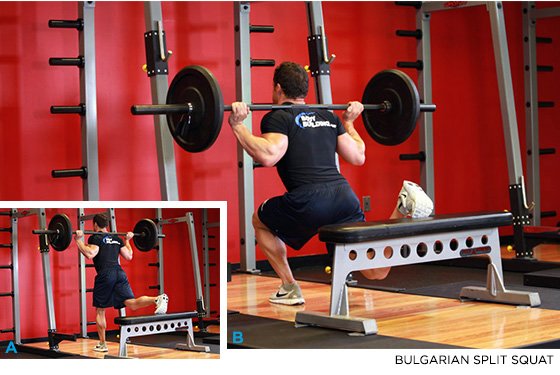
Cues: Place one foot a few feet behind you on a bench or raised platform. Keeping an upright torso, begin by pushing your hips back, like in a back squat. Allow your back leg to bend at the knee.
Descend until you reach the bottom position, which can be when your front leg reaches parallel, or when your back knee touches the ground. It's not uncommon to feel a stretch in the quadriceps and hip flexors of the rear leg.
Challenger 6. One-Legged Squat
Advantages: Balance, mobility, high-tension strength
The one-legged squat, or pistol squat, is the ultimate test of unilateral lower body strength. As with other feats of strength like the one-armed push-up or pull-up, the one-legged squat requires mastery of your bodyweight, balance, and skill. When mastered, it is an excellent and impressive way to build strength throughout the lower body. Until then, it's an excellent way to fall on your can.

Cues: Building up a one-legged squat can be difficult, so approach it as a long-term project. Start by squatting to a high box or bench, being careful to lower yourself under control. Once you can do a few reps at a certain height, lower the box and repeat.
Using this method you should eventually be able to work your way down to a full one-legged squat. Some people find that holding a light dumbbell or plate in front of them helps to balance them, but keep it light. In time, you might be able to perform a one-legged squat with more added resistance.
Challenger 7. Hack Squat
Advantages: Quad strength, lack of spinal compression
Some say the hack squat is as much a deadlift as it is a squat, because the load comes off the ground. However you classify it, the hack squat can be an effective movement for building lower body strength and muscle. It's an under-utilized exercise that places a strong focus on the quadriceps, because leaning forward like in a back squat simply isn't an option.
Due to its strength and mobility requirements, it's best to start off with a reasonably light weight until you get used to it. Your grip strength will have a lot to say about how light.
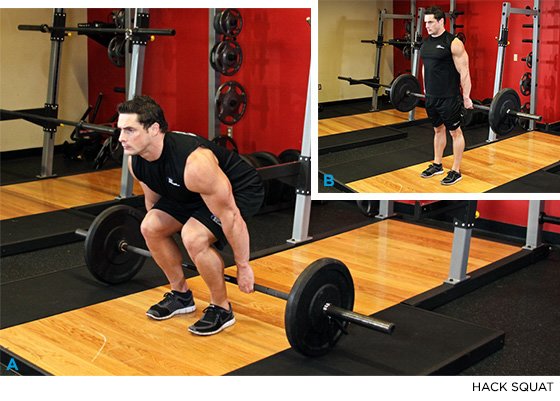
Cues: Position a barbell just behind your legs, with your feet flat on the floor or heels raised on a small plate. Grab the barbell behind you with an overhand (palms facing backward) grip. Keeping your back arched and chest up, extend your hips and knees until you are standing straight up.
Okay, So Which Squat Is for Me?
There's no easy answer to that. A few years ago, it was simpler, because "squatting" still meant pretty much one thing. Today, supporters of front squats and unilateral squats make persuasive cases and see big results. What's clear is that squatting with free weights should be a part of your training.
The movement itself is one of the most athletic things you can do, and training it with a load—no matter how you hold that load—has the potential to make you stronger and more mobile in every part of your life.
The downside to squatting, if there is one, is that it can be a long and lonely road—even if you have a spotter. There's no shortage of people who love to bench, curl, and do basically everything else that they think will make their upper body bigger, but building a monster squat and the legs that come with it takes consistency and serious dedication. After all, who sees your legs other than you?
Yet for lifters who are committed, the rewards are priceless. Don't be the guy with the massive upper body but chicken legs. Load some weight on the bar squat. Your quads will thank you, even if your jeans certainly won't.

